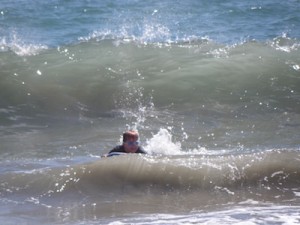The most recent newsletter from Santa Cruz Parent contained some great advice about fun and safety for families at the beach. However, I noticed that it lacked one warning that I think is particularly pertinent to Santa Cruz: Don’t let your kids dig deep holes in the sand! I wrote the following article for Growing Up in Santa Cruz the summer after one child was killed and another was seriously injured after a sand cave collapse. These children’s parents were beach natives and caring people, yet they didn’t realize the risk.
*

For Santa Cruz families, the beach is our free amusement park. As soon as school gets out, families head to the beach for long, lazy, fun days.
Few parents will be able to visit Natural Bridges Beach this summer, however, without the accompanying sadness at last year’s tragedy: one child died and one was seriously injured when a sand cave fell on them. As a community, the good that we can make of such a tragedy is to be more aware of how we can keep our kids safe, while still having fun in our natural playground.
Experts recommend the following precautions:
1) Teach your kids about water.
As soon as they are old enough to understand danger, children should learn about the dangers of water and also learn to swim. Recommendations vary for the age when kids should learn, but everyone agrees that a child playing over his ankles in beach water should be able to float for at least a minute.
2) Teach your kids about the beach.
Beach water is a whole different beast than pool water. Kids should know that sometimes the water is not safe for swimming. You can check our local water quality website before you go.
Kids need to be educated about wave behavior. Rip currents are common at our beaches and kids who can swim should know to swim parallel to the beach if they feel themselves being pulled out to sea. Kids should also understand the behavior of sleeper waves. According to BeachCalifornia.com, “Without warning, huge “sleeper” waves sometimes hit the shore. These giants crash much farther up the beach than normal waves. They can knock down both children and adults, and drag them into deep water.”
Our local cliffs and bluffs are made of sandstone, a highly unstable surface. Teach your kids to pay attention to the warning signs. Noting the young adults who are often out on the cliffs can serve as a way to talk about risky beach behavior. Wildlife on the beach should be looked at and enjoyed, but never touched or bothered. Report injured wildlife on our beaches to the State Park Service.
3) Be a responsible adult.
Sometimes it’s a pain to enforce safety rules. For example, kids love the warm, stagnant water caught at slow-moving creek entrances. These bodies of water are permanently posted for unsafe bacterial levels, and parents need to be vigilant.
All kids, even those with more melanin in their skin, need to wear sunscreen at the beach. According to WebMD.com, “Research has shown that sun exposure prior to the age of 18 significantly increases the risk of developing skin cancer later in life, including the potentially fatal melanoma.”
Beaches with smaller waves and lifeguards are safer for kids. Choose the beach based on their needs. And if they are going in deeper water with a body board, even if they can swim, they should have a tether. Kids (and adults) can drown when they swim out to retrieve a board that slipped out from under them.
4) Sand caves are not safe.
Finally, it’s nearly universal in kid world that digging in sand and going in caves is endlessly fun. But parents need to be aware that on average, three people, mostly kids, are killed on beaches each year by sand cave-ins, often from lying down in shallow holes and aspirating falling sand. No child should be allowed to dig a large hole deeper than a foot, and children should be told never to lie down, even in shallow holes.
It can be uncomfortable, but parents can help other parents keep their kids safe. Many of the visitors to our beaches are newbies – we can help them by pointing out unsafe behavior when we see it. If the problem continues, you can contact a lifeguard or the ranger on duty at each beach’s parking area.
Enjoy a safe, happy summer!
Resources:
- www.webmd.com
- www.aquaticsafetygroup.com
- www.beachcalifornia.com
- Santa Cruz County Environmental Health Department: http://gis.co.santa-cruz.ca.us/PublicWaterQuality/